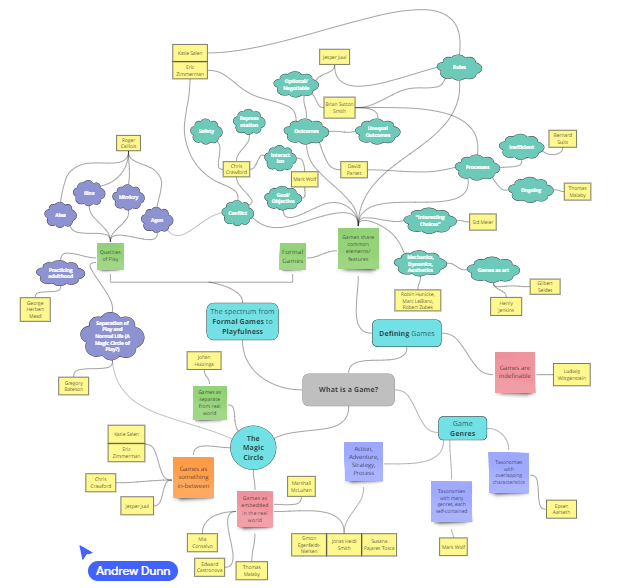By the end of my MET program, I will be able to articulate the role of theory and evidence-based approaches through the development of a curriculum to support faculty in online teaching readiness.
Goal #1
Goal 1 Main Page | Artifact #1 | Artifact #2 | Artifact #3 | Artifact #4
Format: Mind Map and Video
Course: ETEC 544 Digital Games and Learning
As part of the course on digital games and learning I was tasked to think about the theoretical underpinnings of games and of play. I created a mind map using Miro. I chose Miro as the platform because it allows for the incorporation of additional media (in this case a walkthrough video and an H5P accordion interactivity).

Guiding Theories and Frameworks
- My thinking was influenced by various theorists on games in education (see the artifact for details), including a friend of mine from my time at Heriot Watt University, Dr Nicola Whitton (e.g. Whitton, 2010). Salen (Tekinbaş) and Zimmermann was perhaps the most influential resource on the actual design of a digital game:
- Csikszentmihalyi’s concept of Flow (Tekinbaş and Zimmermann, 2003) describes a state of complete immersion and enjoyment in an activity. Games are particularly effective at inducing flow, which can enhance learning by keeping learners engaged and motivated. There is certainly a lesson here for how we (re)design the training offered to faculty to support online teaching readiness.
Reflections
Reflecting on this artifact, I realize that the process of creating the mind map and video was not just an exercise in understanding the concept of a game, but also a way to better understand the process of learning. The mind map served as a visual representation of my thought process, allowing me to see the connections between different concepts and ideas, each node and connection revealing a new layer of understanding about games and play.
The video walkthrough and the H5P accordion interactivity added another dimension to my learning. They allowed me to engage with the material in a more dynamic and interactive way, reinforcing my understanding of the concepts. There are obvious lessons here for the way we teach faculty online, and in turn for the way faculty teach online students.
As I delved deeper into the theoretical underpinnings of games and play, I realized that these theories could have a profound impact on online course design and delivery. The characteristics of play, such as game goals, outcomes, and conflict, could be employed to create engaging and effective educational interactivities. This insight has opened up a new avenue for exploration – the creation of a workshop on gamification, promoting gamified techniques in the online teaching provided by faculty.
Looking back, I can see how this artifact has not only deepened my understanding of games and play but also enriched my approach to teaching and learning. It has shown me the power of visual and interactive learning tools, and the potential of game-based learning strategies. As I move forward, I am excited to apply these insights to my work, and to continue exploring the fascinating world of digital games and learning.